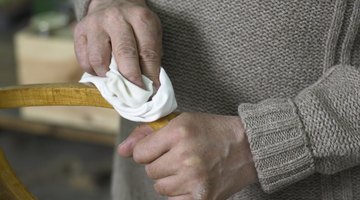How to Fix Wood With White Discoloration

Wood shouldn't have any white areas unless you've painted it. However, cloudy white patches are one of the more common problems for wood or wood finishes. The white can originate in the finish -- the most typical -- or exist in wood fibers due to abuse, weather or minerals in the wood. Professionals deal with white discoloration all the time. Apply a few tricks that woodworkers use to remove white discoloration.
Moisture
White discoloration can be caused from different things, some not what you might think. White spots on tables or furniture are typically caused by moisture in the finish. It appears to be in the wood, but it's only finish-deep. You might notice them as circles where where cups have been placed or where water has spilled. White spots can also be caused by placing hot, moist items on the table such as pizza or takeout boxes. To remove white spots like this, try hovering a hot iron over the spot for a few minutes. If that doesn't work, place a cotton cloth on the white spots and place the iron directly on the cloth. Move the hot iron over the cloth gently as if you were ironing the cloth. Check your progress and you should see the white discoloration fade as the moisture evaporates from the finish. Don't use excessive heat and keep the iron moving. Continue until the discoloration disappears. Finish by wiping it down with a quality furniture polish that contains natural oils.
Blushing
Blushing is another finish-related problem. It looks just like it sounds with whitish or faded areas that appear to be in the wood, but only run finish deep. This is also caused by moisture, but this type of moisture comes from finishing wood on a rainy day, or when the temperature is cold and the finish dries too slow. Blushing is typically lighter, with more surface area involved than simple water rings caused from cups or spills. If you notice doors, woodwork such as molding, trim around windows or even baseboards with blushing, dampen a cloth with lacquer thinner and wipe the whitish area. Rub with the discoloration with strokes parallel to the grain. If you feel the finish become tacky, move on, and don't rub too hard. The whitish discoloration should begin to disappear immediately. If it doesn't go away completely, allow it to dry for a few minutes and reapply the dampened cloth. If the finish feels slightly rough afterward, rub it lightly with high-grit steel wool and spray it with a light coat of aerosol lacquer.
Deeper Problems
If you've tried ironing and wiping with lacquer thinner and the white discoloration remains a problem, it's probably because the wood has been bleached by the sun, or the finish is worn off. This type of repair can often be taken care of by an application of oil-based stain. Oil stains contain natural penetrating oil that sinks into the fibers of the wood and hardens. Choose a stain with tung oil, linseed oil, walnut oil, mineral oil or any other natural oil that has stain mixed into it. Wipe the discolored area with the oil stain and allow it to remain on the surface of the wood for at least 15 minutes or longer and then wipe it off. If the whitish color remains, add another application of oil stain and repeat. If it continues to appear white, try a darker color. When the white discoloration is removed, allow the wood to dry for at least 72 hours and apply wood paste wax to the area and buff to a smooth, shiny finish.
Minerals
Sometimes you have to start over with bare wood. Mineral deposits in wood often appear as white or light gray streaks or blotches. This type of discoloration is often in the wood from the beginning resulting from poor finishing techniques. The only way to remove this type of whitish discoloration is to remove any other top coats and sand the white out. In most instances, an orbital sander equipped with 80-grit for aggressive wood removal, or 100-grit sandpaper for more moderate discoloration. Apply the sander directly to the wood. Move it back and forth with the grain until the wood takes on a natural amber color. Once the wood looks natural, sand it again by hand with 100-grit sandpaper attached to a hand sanding block with strokes parallel to the grain. Refinish as needed with oil stain and or lacquer or varnish for best results.
Writer Bio
Specializing in hardwood furniture, trim carpentry, cabinets, home improvement and architectural millwork, Wade Shaddy has worked in homebuilding since 1972. Shaddy has also worked as a newspaper reporter and writer, and as a contributing writer for Bicycling Magazine. Shaddy began publishing in various magazines in 1992, and published a novel, “Dark Canyon,” in 2008.
Photo Credits
- Michael Blann/Photodisc/Getty Images
- Michael Blann/Photodisc/Getty Images
More Articles



